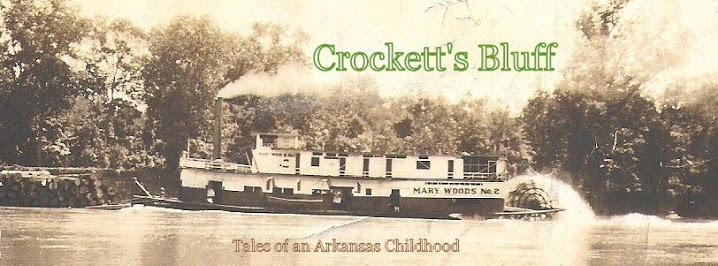When I was a boy in in the old house on the hill overlooking the White River in Crockett's Bluff in the late 1930s and 40s, we took birds for granted - domestic as well as wild. There were birds aplenty flittering about thoughout the days and nights in every season in a genuine "free range' environment. Though many folks had "chicken pens," chickens have a way of freeing themselves to wander, a freedom that many households allowed, only to gather them into the pens at the end of the day to sleep in their nests in a "chicken house", away from the various four legged vermits that wandered about the country side at night, sheds at least with a roof and stalls for egg providers.
In the 1930s in places like the Bluff almost any animal, wild or domestic, was considered edible. There was not, to say the least, a lot of money at hand. There were fruit trees, pears and apples in the remnants of the old orchards established by the Prange family, the previous owners of the land. We raised chickens, of course, and there were always fish from the lakes and the White River, but most larger migratory fowl - mallards and Canada Geese, as well as doves and quail - were eaten, and I can recall having racoon with sweet potatoes (quite tasty, actually).
So-called bird watching was unknown, and I cannot recall anyone who had a bird house. Their sounds were routine background noise, especially the Whip Poor Wills and Mourning Doves that seemed to have, along with the Bull Frogs over the hill in the Prange pod, a general audience to themselves from the ancient oak trees at the back of the garden during that lovely half hour or so on a summer night when the sun had set before night fell.
During my most recent visit to the Bluff a few weeks ago on the occasion of the funeral of my brother Shelby, I fought the swarms of gnats to at least drive through the old home place, now owned and neatly maintained by my nephew Gary Woodiel. The old house and all the outbuildings are long gone, but the remnants of the oldest trees still stood, the pecan near where the old house stood and the old oak on the edge of the hill where I used to park the school bus which I drove during my senior year at St. Charles High School.
As we drove down the short drive past the metal "Woodiel Lane" sign it was obvious that Spring had arrived in all its richness, leaving every local botanical species glowing in lush greenness. But as we reached the top of the rise to which in my childhood was our front yard, everything changed.
Suddenly, it was apparent that in almost any direction one looked, among every dozen trees or so, there was a birdhouse of some style in a variety of bright colors!
As we drove down the short drive past the metal "Woodiel Lane" sign it was obvious that Spring had arrived in all its richness, leaving every local botanical species glowing in lush greenness. But as we reached the top of the rise to which in my childhood was our front yard, everything changed.
Suddenly, it was apparent that in almost any direction one looked, among every dozen trees or so, there was a birdhouse of some style in a variety of bright colors!

No comments:
Post a Comment